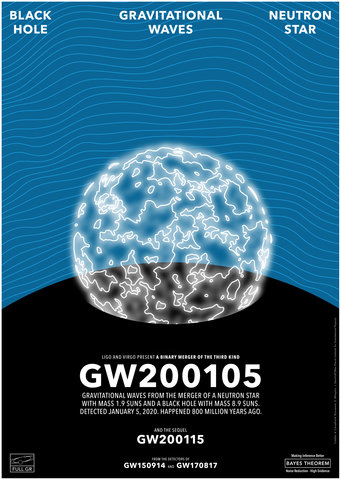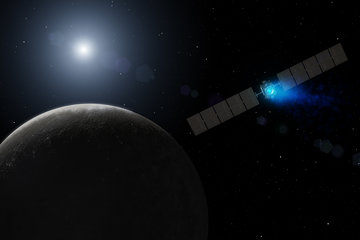Feast for black holes
Detectors receive gravitational waves from two gravity traps that swallow neutron stars in one piece
LIGO, Virgo and KAGRA researchers present two new gravitational-wave events, which were detected within just ten days in January 2020 during the second half of the third observing run. The signal observed by the LIGO and Virgo detectors is the first robust detection of a black hole merging with a neutron star. The waves came from distances of more than 900 million light-years, where the neutron stars were swallowed whole by their black hole partners. While no light was seen from either event, the gravitational waves were heard loud and clear. They allow the researchers to draw first conclusions about the origin of these rare binary systems and how often they merge. The results were published in Astrophysical Journal Letters today. Scientists at the Max Planck Institute for Gravitational Physics (Albert Einstein Institute; AEI) in Potsdam and Hannover and at Leibniz University Hannover have contributed to the discoveries and their interpretation.

The two gravitational-wave events, nicknamed GW200105 and GW200115, were observed on 5 January 2020 and 15 January 2020, respectively. These first results from O3b – the second half of the LIGO and Virgo detectors’ third observing run – and their astrophysical implications were published in Astrophysical Journal Letters.
“Within just ten days in January 2020 our detectors picked up two brand-new signals. They came from black holes of 9 and 6 solar masses, that collided with two lighter objects of 1.9 and 1.5 solar masses, respectively,” says Alessandra Buonanno, director at AEI Potsdam and professor at the University of Maryland. “GW200115 is our first robust detection of a neutron-star–black-hole merger! This compelling new source of gravitational waves completes our collection of merging compact objects.”
The first of the two events, GW200105, was detected as a strong signal by one of the LIGO detectors, while the other was temporarily offline. From the gravitational waves the astronomers inferred that the signal was caused by a 9-solar mass black hole colliding with a 1.9-solar mass compact object. They concluded that the latter object is a neutron star. This merger happened at a distance of about 900 million light-years.
“Even though we see a strong signal in only one detector, we conclude that it is real and not just detector noise. It passes all our stringent quality checks and sticks out from all noise events we see in the third observing run,” says Harald Pfeiffer, group leader in the Astrophysical and Cosmological Relativity department at AEI Potsdam and professor at the University of Potsdam.
Because it was found by a single detector, the direction to the waves’ origin cannot be determined very precisely: to about 17% of the entire sky, equivalent to the area covered by 34,000 full moons.
The second event, which was detected only 10 days later (GW200115), was seen by all three large detectors: both LIGO instruments and the Virgo instrument. While it is less prominent than GW200105 in each single detector, the combined information and coincident detections make it a strong signal. GW200115 comes from the merger of a 6-solar mass black hole with a 1.5-solar mass neutron star. The collision took place roughly 1 billion light-years from Earth.
With observations of the three widely separated detectors on Earth, the direction to the waves’ origin can be determined to a part of the sky equivalent to the area covered by 2,900 full moons.
Several follow-up observations by multiple observatories were carried out, but no counterpart of either event was seen in electromagnetic waves.
“Even though observing an electromagnetic signal from the merger would’ve been fantastic, we did not necessarily expect that to happen,” says Frank Ohme, leader of an Independent Max Planck Research Group at AEI Hannover. “Any light would be very faint because of the large distances and it would be difficult to find because the sky positions are not very well known. Also, we infer that the black holes involved in those mergers just swallowed their neutron star partners whole without any light show at all.”
Simulation of GW200115
From the gravitational-wave signal alone it is impossible to tell with certainty whether the lighter objects are in fact neutron stars. There is no clear evidence for or against the fingerprints of the expected neutron star deformations in the signal. “While the gravitational waves alone don’t reveal the structure of the lighter object, we can infer its maximum mass. By combining this information with theoretical predictions of expected neutron star masses in such a binary system, we conclude that a neutron star is the most likely explanation,” says Bhooshan Gadre, a postdoctoral researcher in the Astrophysical and Cosmological Relativity department at AEI Potsdam.
Because the two events are the first confident observations of gravitational waves from black holes merging with neutron stars, the researchers can estimate how often such events happen in the Universe. They expect that roughly one such merger per month happens within a distance of one billion light-years. Not all of those events are detectable with the current detectors.
While it is unclear how these binary systems formed, there are three possibilities the astronomers identified as most likely. Stellar binaries can become such systems as their stars evolve over time into black holes and neutron stars. Dense stellar environments such as young star clusters are another promising cosmic origin, as well as the surroundings of the centers of galaxies.
AEI researchers have significantly contributed to the analyses presented in the paper. They have provided accurate waveform models of coalescing compact objects, such as black holes and neutron stars, that include the precession of the objects' spins, multipole moments beyond the dominant quadrupole, as well as the neutron star's tidal effects. Those physical features imprinted in the waveform are crucial to extract unique information about the sources' properties. AEI researches have also actively participated to the analyses and preparation of the results for publication. The high-performance computer clusters “Minerva” and “Hypatia” at the AEI were employed in the development of the waveform models; they were also used in analyzing the observed signals.
“We are currently preparing the detectors for their fourth observing run which is scheduled to begin in the summer of 2022. They will be even more sensitive and we might observe gravitational waves every day,“ says Karsten Danzmann, director at AEI Hannover and director of the Institute for Gravitational Physics at Leibniz University Hannover. “A few years from now we will have seen additional black-hole—neutron-star mergers and will have learned more about matter under extreme conditions, about the lives of stars, and the properties of these rare events.”
EM / KNI / HOR













